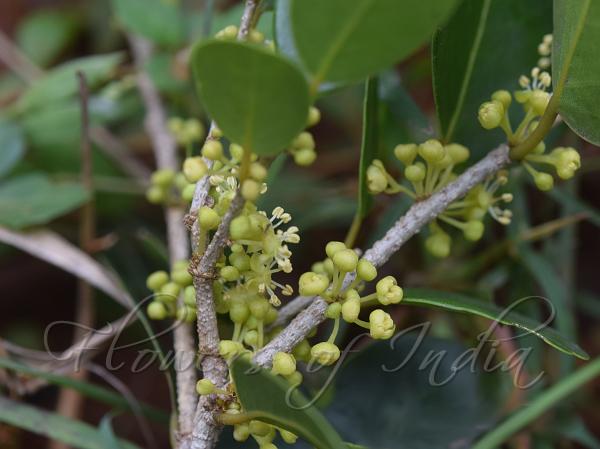|
| Hedge Boxwood |
|

|

| File size | 405061 |
| Original date | 11/30/17 3:03 PM |
| Resolution | 2048 x 1536 |
| Flash | Flash did not fire, auto |
| Focal length | 90.0mm |
| Exposure time | 1/160s |
| Aperture | 6.3 |
| Focus Distance | |
| Metering Mode | Multi-segment |
| Camera make | NIKON CORPORATION |
| Camera model | NIKON D3300 |
| Sensor type | OneChipColorArea |
|
|
|
|
Photo: |
Botanical name: Drypetes sepiaria Family: Putranjivaceae (Puranjiva family)
Synonyms: Hemicyclia sepiaria
Synonyms: Hemicyclia sepiaria
Hedge Boxwood is an evergreen tree, up to 15 m high,
bark grey, thin, smooth; branchlets yellowish or blackish, round.
Leaves are simple, alternate; stipules small, falling off; leaf-stalk
3-8 mm, stout, finely velvet-hairy; blade 2-9 x 1.5-4.5 cm, ovate,
elliptic, ovate-oblong, ovate-elliptic or round, base round or
heart-shaped, tip blunt or round and retuse, margin entire or rounded
toothed, thickly leathery, hairless, shining; lateral nerves 4-8 pairs,
slender, pinnate, obscure, ascending, intercostae netveined, obscure.
Flowers are unisexual, yellowish, in in leaf-axils clusters; male
flowers: flower-stalk 4-7 mm, velvet-hairy; tepals 4, 3-4 x 2.5-3.5 mm,
small, concave, fringed with hairs, blunt, overlapping; stamens 6-10;
filaments 2 mm, free; anthers oblong; disc disciform or shortly
cup-shaped; female flowers: flower-stalk 1-10 mm long, velvet-hairy;
tepals 4, 2-4 x 1.7-3.5 mm, small, concave, fringed with hairs; disc
annular, rounded toothed; ovary ovoid, 1-1.5 mm across, 1-locular,
ovules 2; style 1; stigma broad, cup-shaped, peltate, fringed. Fruit is
a drupe 8 mm across, spherical, hairless, red; epicarp crinkled; seed
1, arillate. Hedge Boxwood is found in India and Sri Lanka
Medicinal uses: This plant is used in folk
medicine by the tribal people of Western Ghats to treat pain and
inflammation. The seeds of this plant are used as a wild edible food by
Palliyars (tribal Group) of Western Ghats
This plant is used in folk
medicine by the tribal people of Western Ghats to treat pain and
inflammation. The seeds of this plant are used as a wild edible food by
Palliyars (tribal Group) of Western Ghats
Medicinal uses:
 This plant is used in folk
medicine by the tribal people of Western Ghats to treat pain and
inflammation. The seeds of this plant are used as a wild edible food by
Palliyars (tribal Group) of Western Ghats
This plant is used in folk
medicine by the tribal people of Western Ghats to treat pain and
inflammation. The seeds of this plant are used as a wild edible food by
Palliyars (tribal Group) of Western Ghats | Identification credit: S. Kasim | Photographed in Vellore Dist, Tamil Nadu. |
• Is this flower misidentified? If yes,